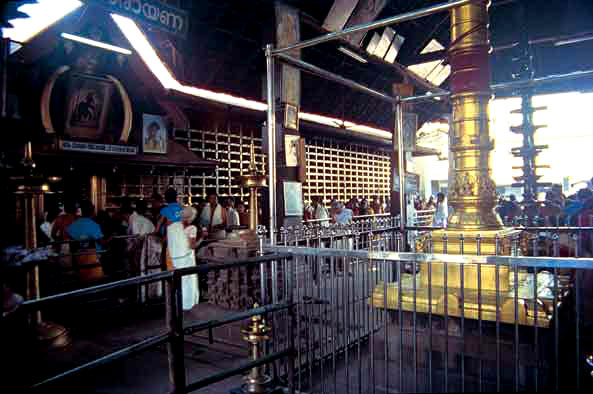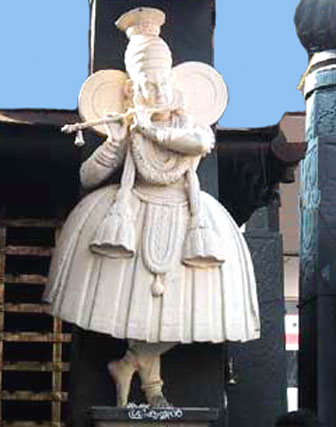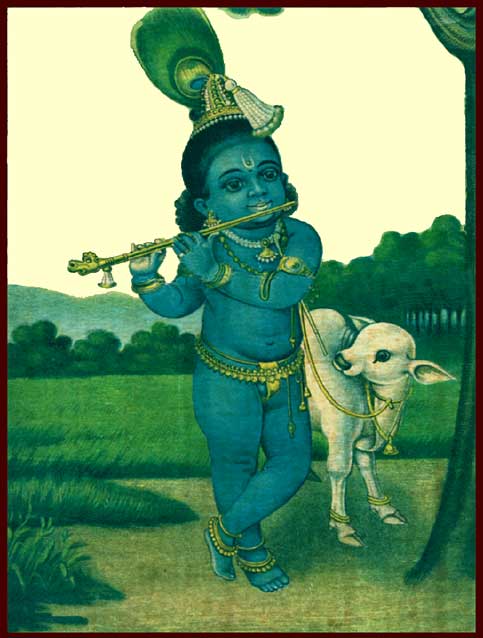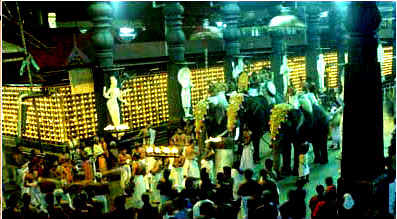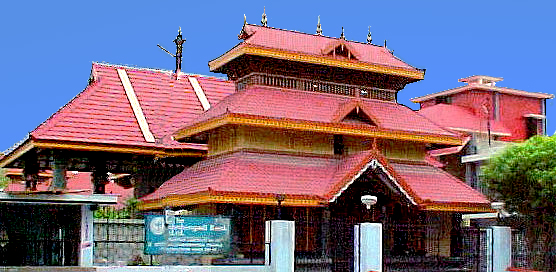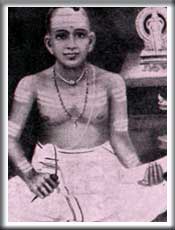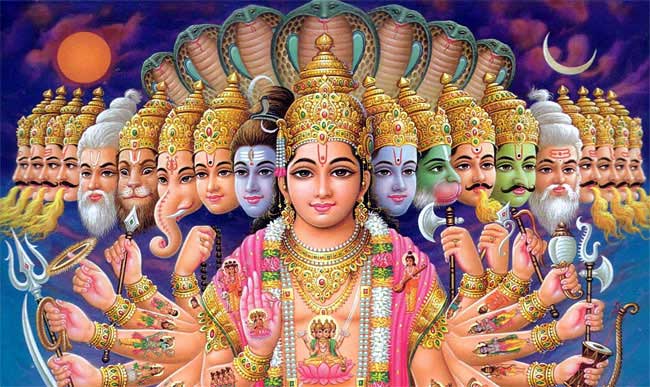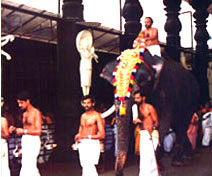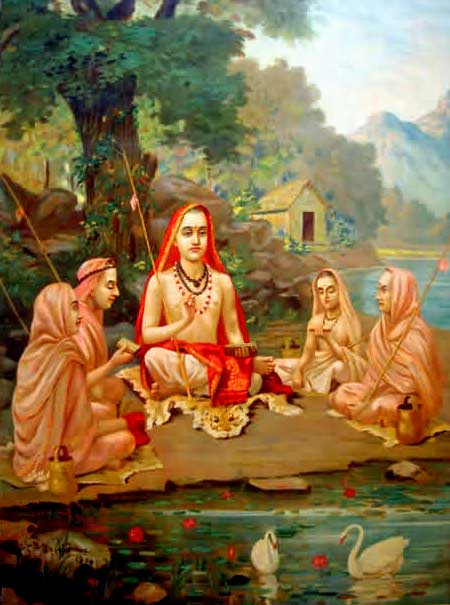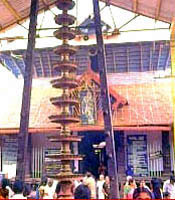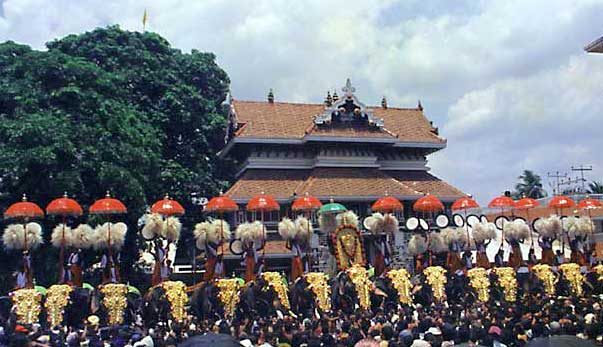|
|||||||||||
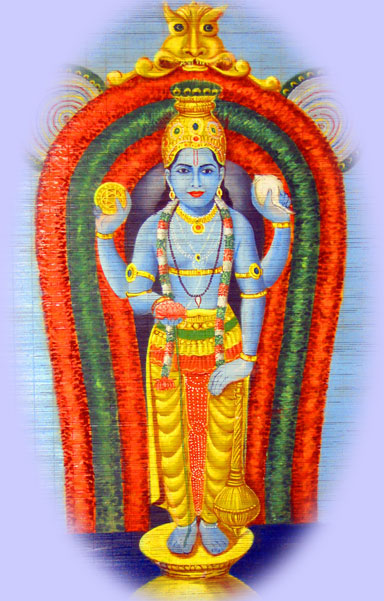  |
|||||||||||
|
The temple is classified
as one of the Mahakshetras or “Great abodes of worship”. There are many
such in the holy land of India but few which can claim to have all the
ten qualifications of a Mahakshetra.
krishnattam
Lord Krishna The history of the idol goes back to the hoary past to the age of Dwapara when Lord Krishna was alive. His parents were Vasudeva and Devaki. She was the sister of Kamsa, the cruel king of Mathura. They two of them had been great devotees of Lord Vishnu for many ages. After assiduously wooing him for many births, the Lord had manifested himself to them and promised that he would be born as their son for three lives in succession. He promised them liberation at the end of these three births. This was their last birth as Devaki and Vasudeva in the clan of the Yadavas in the city of Mathura and Krishna was born to them as their eighth son. The idol of Lord Vishnu which is found in Guruvayoor is one which had been worshipped by Devaki and Vasudeva and one can easily imagine that it must also have been worshipped by Lord Krishna himself. This is the greatness and glory of this particular idol of Lord Vishnu – that Vishnu himself had done puja to it in his incarnation as Krishna.
At the end of his earthly sojourn, Krishna prophesied to his friend and devotee, Uddhava that the island of Dwaraka, which had been his stronghold, would be swept away by the sea, seven days after he left his mortal body. He instructed him to rescue the precious idol of Vishnu which his parents had worshipped, and hand it over to Brihaspati, the guru of the gods who would come to him. After seven days, the island submerged in the sea as foretold by Lord Krishna. Uddhava went sadly to the seashore and saw the idol bobbing up and down on the waves far out in the sea. He begged the wind god – Vayu to bring it closer to him. The wind wafted it gently to the shore and Uddhava picked it up lovingly and cradled it in his arms. As he was wondering how to contact the guru of the gods, he found that Brihaspati himself was walking towards him. Uddhava told him the whole story of how Lord Krishna had instructed him and Brihaspati who knew everything agreed to take it and install it at some special place. He was sure that he would be given further instructions. Now Brihaspati asked Vayu, the wind god to transport him through the air so that they could choose a perfect spot for the installation. Carrying the precious idol in his hands, Brihaspati was wafted across the sub-continent of India till they came almost to the sea shore to the spot where the present town of Guruvayoor now stands. Looking down Brihaspati saw a beautiful lake filled with lotuses on the banks of which Shiva and Parvati were dancing. He was charmed by the sight and he requested Vayu to float him down. For some time he stood spell-bound by the dancing couple. When they had finished he prostrated to them and begged Shiva to tell him of a perfect spot to install the idol of Vishnu. Shiva said that this was indeed the ideal place. He told him to build the temple right there at one end of the lake where he and Parvati had been dancing. He magnanimously said that he himself would take up residence at the other end of the lake which was known as Rudrathirta. The temple of Mammiyoor to which Shiva shifted still exists. However during the course of time the lake dried up little by little and now only the temple tank adjoining the Guruvayoor temple remains to tell the tale of this ancient lake. The word Guruvayoor has special connotations. It is made up of two words “guru” and “vayu”. Guru means preceptor and vayu is wind. The idol was installed by Brihaspati, the guru of the gods and Vayu, the god of wind and hence came to be known as Guru-vayoor! The word also has an esoteric meaning. It stands for the body of the human being which is the abode of wind. The five pranas or vital breaths are what sustain the body and make it function properly.
Rudrathirta, Temple of Mammiyoor Though the idol traces its antiquity to the Dwapara Yuga, the present temple is only about five hundred years old. However the shrine must have existed in some form or other even at the time of the Mahabharata. When the Pandavas departed from this world, they left their kingdom to Arjuna’s grandson, Parikshit who was their only surviving progeny. Parikshit died of snake bite and his son Janamejaya swore to take revenge on the king of snakes and carried out a huge sarpa yajna, or sacrifice of snakes, in which thousands of snakes perished in the flames. For this heinous crime he was cursed by the snakes and became a leper. Forced to leave his palace and his kingdom, he wandered miserably from temple to temple till he came to the shrine of Lord Guruvayoorappan. Here it is said that he did tapasya for many months and was eventually totally cured of his dread disease. The next mention of the temple is in the annals of the history of the Pandyan kings who ruled south India in the 14th and 15th centuries. The legend goes that one of the kings of this dynasty was told that he would die of snake bit. In despair he went and prayed at the shrine of Lord Guruvayoorappan till the day which had been foretold by the astrologer came and passed without mishap. He questioned the astrologer about this and was told to examine the heel of his left foot carefully. There he saw the marks of a snake’s fangs. Due to the grace of Lord Guruvayoorappan he had been saved from sure death. The grateful king built the temple and endowed it with funds to carry out the pujas. The present structure of the temple hails from that time. Another miracle recorded in the temple history happened in the 16th century. The famous poet and scholar, Meppathur Narayana Bhattathiri, composed the poem known as “Narayananeeyam”, which is a wonderful epic in Sanskrit consisting of one thousand and thirty six verses. The composition of the poem is connected with a miracle.
Melpathur Narayana Bhattathiri Narayana Bhattathiri was born is a family of Namboodiris, who are the Brahmin caste of Kerala. By the age of sixteen he was a great Vedic scholar. However he soon fell into bad company and began to neglect the daily duties enjoined on him by his caste and upbringing. His father-in-law was a very pious and learned astrologer. One morning when he was seated on the veranda scrutinising a yantra in front of him, Bhattathiri who had woken up late came rushing out and in his hurry to reach the yard he jumped over the sacred yantra. The old man rebuked him in strong terms for his negligence in the pursuit of his swadharma and for dissipating this human life which should have been spent in the pursuit of the final goal of liberation. Somehow the effect of this rebuke was electrical. He realised his mistake and promised to mend his ways and begged the old man to accept him as his disciple. Bhattathiri became one of his greatest disciples. In his later years the astrologer was stricken with crippling rheumatoid arthritis. Bhattathiri was a very great devotee of Lord Guruvayoorappan by this time and he begged the Lord to allow him to take over the disease of his master. Needless to say the old man improved and Bhattathiri contacted the dread disease. He was totally afflicted and could hardly move. He made his friends take him to Guruvayoor. Every morning he would take his bath and be carried to the temple. Here he sat propped up by the wooden pillar on the eastern side of the southern porch and composed his immortal classic called “The Narayaneeyam” which is a condensed version of the Srimad Bhagavata Purana which describes the glories of all the ten incarnations of Vishnu with special reference to the Krishnavatara. The hundred-canto poem follows the original closely and describes all the incarnations of Lord Vishnu starting with the “Fish”. Naturally he elaborated at length on the life of Lord Krishna. Every day painfully, he would continue with his self imposed task and at the end of each canto he would beg the Lord to cure him of his dire disease.
Lord Narayana The special thing about “The Narayaneeyam” is that it is addressed directly to the Lord of Guruvayoor. Bhattathiri imagined the child Krishna sitting in front of him listening avidly to the stories of his own incarnations. Hence many of the stories sound as if they are being told to a child. At times the pain would be too intense for him and he would stop in the middle of a story and throw his stylus down and refuse to go any further even though the child was anxious to hear the end of the story. At this time it is said that the child Krishna would come close and stroke his limbs and make him fit to carry on with the tale the next day. As the days and months slipped by with Bhattathiri singing the praises of the Lord, he got progressively better. By the time he sang the last canto he was completely cured. Moreover he was blessed with a vision of the Lord standing inside the sanctum and smiling at him. The hundredth canto is a description of this beatific vision. He starts this canto with the words, “In front of me I am seeing…” Bhattathiri lived to the ripe old age of a hundred and six years. He spent most of his life in the temple worshipping the Lord of his heart. The poem is indeed a gem of both devotion and erudition. Even though most of the temple has been re-modelled and the pillars changed into marble, the wooden pillar on which Bhattathiri rested during his arduous labour of love is still retained. Mention should also be made here of some of the famous devotees of the Lord of Guruvayoor. The old Namboodiri Brahmin known as Poonthanam was a great devotee and many miracles took place during his lifetime. What he lacked in erudition he made up in devotion and his famous poem called “Jnanapana” is a masterpiece of devotion and wisdom. Vilvamangalam was another great devotee. Krishna is said to have appeared in person and sat before him whenever he did his puja! Another great devotee was Kururamma who was a childless widow. When she grew too old to attend to her own necessities it is said that the boy Krishna came to her in the form of a servant boy and did all her menial work for her! Prince Manavedan who was the Zamorin or ruler of Calicut was also a great devotee. He composed the ten chapters in the life of Krishna known as Krishnattom Kali which is a unique dance form of this temple. At one time these ten episodes in the life of Krishna, starting with his birth and ending with his ascension could only be played in the temple or the royal palace. However now due to its greatness it is now being played in other places also. Manavedan is said to have had the good fortune of embracing Krishna when he actually appeared during one of the scenes.
The present pujas or rituals which are conducted in the temple are reputed to have been established by Parashurama, the sixth incarnation of Vishnu, who is supposed to have established most of the ritualistic observances in all the great Kerala temples. There is an interesting story about Adi Shankaracharya, the famous founder of Advaita Vedanta or the school of non-dualism which is connected with the temple of Guruvayoor. At that time Shankaracharya advocated only meditation on the supreme Brahman, the formless Absolute. He possessed many siddhis or supernormal powers and one day when he was travelling through the air, he happened to pass over the temple of Guruvayoor where Guruvayoorappan was being carried round on an elephant on his daily morning ride! This is a ritual which takes place three times a day and crowds flock to see the pageant. Shankaracharya was about to pass on with hardly a glance at the procession below, when despite his fabulous powers, he found himself forcibly dragged to the ground in order to bow to the embodied Brahman who was being carried round on an elephant!! After this he became a great devotee of the Lord. It is to be noted that even though he was a pure advaitin or advocate of the non-dual reality of Brahman, he established many temples all over India including the Himalayan shrines of Badrinath and Kedarnath and laid out the types of rituals to be followed therein!
Adi Shankaracharya Many cases of cures and miracles have been attributed to Guruvayoorappan. In fact the monthly magazine of the temple describes the personal experiences of many devotees that continue to take place even now. The temple opens at 3 AM and closes late at night very often at 10 PM or even later when there are special functions. One has to queue for hours to get a fleeting glimpse of the charming figure inside the sanctum sanctorum. The Lord is decorated in various ways during the different pujas. Early morning he is shown as a young child wearing only a small red kaupina and various bits of simple jewellery as befitting a child with a peacock feather in his coronet. He holds a ball of butter in his hand. For the next puja at 10 AM he looks a little older. He is fully adult by the noon puja which is the most elaborate. This ornamentation remains on him till the next morning. It is a strange experience of most true devotees that even though the crowds may be great somehow or other they manage to get a close up view of the Lord even though many people have to leave without being able to get inside. One of the striking features of this temple is that the idol has been so placed that it is visible from very far off, way beyond the main temple doors. The web master, Arvind Burger being an American would not have been allowed to go inside since the temple is not open to non-Hindus, but in his own miraculous fashion, Guruvayoorappan literally took him by the hand and allowed him to have darshan from inside the inner courtyard without any of the guards noticing his white skin!!
View of the idol from outside temple! The author of this article hails from this town. Her grandfather was one of the Zamorins of Calicut. Her family house has existed here for generations and all those born in that family have the tradition of being great devotees of the Lord. In fact the name “Vanamali” which she has adopted as her spiritual name is another name of Lord Guruvayoorappan since he wears a garland of five wild flowers round his neck. A set of people are employed by the temple for the sole purpose of making garlands for the Lord since they are continuously being changed. The history of the family contains many incidents of various miracles that have taken place due to the grace of Guruvayoorappan. They have a tradition that whenever a baby becomes three months old it is taken to the temple by the mother and left at the doorway of the Lord. She then turns away and walks off since she has now given over the charge of child to the Lord. From then on the child is a vassal of the Lord. Even though the family members are now scattered over the face of the globe this tradition is still followed and all of them feel a keen and inseparable bond with the delightful blue boy of Guruvayoor. May the grace of the Guruvayoorappan fall on all those who read this! Hari Aum tat Sat
Thrissur Pooram near Guruvayoor |
About Vanamali Ashram |
Ashram Store |
Satsang |
Miracle at Vanamali |
Bhagavad Gita |
Home |
Vanamali Love Songs |
|
|

